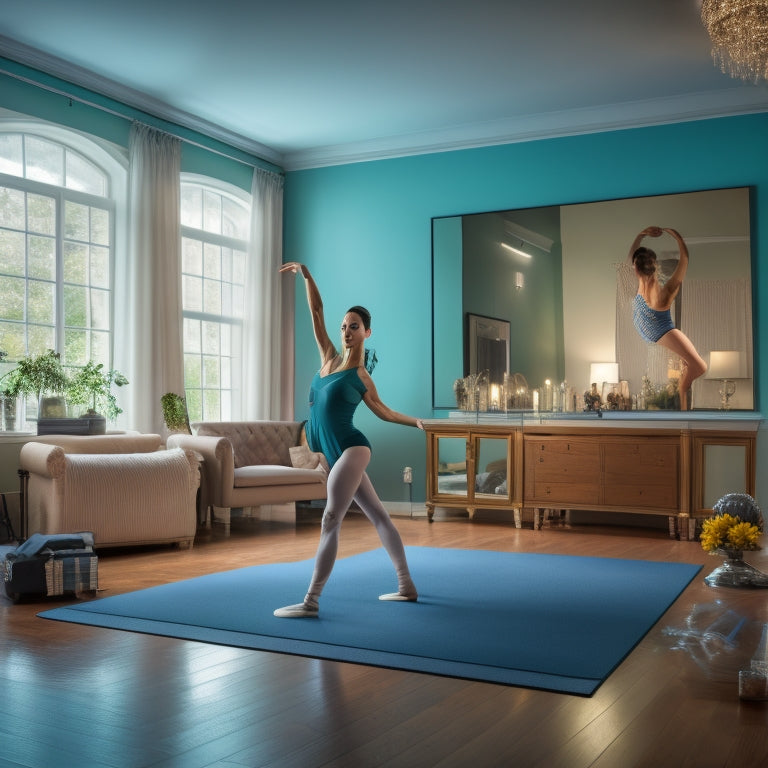
7 Best Flexibility Exercises for Dancers at Home
Share
As a dancer, you know that flexibility is key to perfecting your craft. But, let's face it, finding time to fit in a stretching routine can be tough. That's why incorporating flexibility exercises into your daily routine at home can be a game-changer. You're probably wondering, what are the most effective exercises to focus on? From Cobra Pose to Hip Openers, we'll explore the 7 best flexibility exercises you can do from the comfort of your own home to take your dancing to the next level. Want to know the secrets to improving your flexibility and performance?
Key Takeaways
• Incorporate Cobra Pose to strengthen and stretch muscles between shoulder blades, improving posture and flexibility.
• Practice Splits to target hip flexors, quads, and hamstrings, enhancing overall flexibility, balance, and range of motion.
• Perform Leg Swings to dynamically target the hip joint and surrounding muscles, improving flexibility, balance, and range of motion.
• Use Forward Folds to stretch hamstrings, maintaining proper alignment and engaging the core to deepen the stretch.
• Incorporate Shoulder Rolls into daily routines to improve posture, increase blood flow, and reduce muscle tension.
Cobra Pose for Upper Back
As you begin to incorporate flexibility exercises into your dance routine, start by targeting your upper back with the cobra pose, which strengthens and stretches the muscles between your shoulder blades. This foundational pose is essential for dancers, as it improves posture, reduces tension, and enhances overall flexibility.
To execute the cobra pose safely and effectively, focus on proper breathing techniques. Lie on your stomach with your hands under your shoulders, engage your core, and inhale deeply. As you exhale, slowly press your palms into the ground, lifting your chest and head off the mat. Keep your shoulders down and away from your ears, feeling the expansion in your chest. Hold for 30 seconds, breathing naturally, and release slowly.
Repeat for 3-5 repetitions, gradually increasing your holding time as you build strength and flexibility. By incorporating the cobra pose into your routine, you'll experience improved flexibility, reduced muscle tension, and enhanced overall dance performance.
Splits for Hip Flexibility
While strengthening your upper back with the cobra pose, don't overlook the importance of hip flexibility, which you can greatly enhance by mastering the splits, a fundamental exercise for dancers that targets the hip flexors, quadriceps, and hamstring muscles.
Performing the splits regularly will improve your overall flexibility, balance, and range of motion. To get started, try the following variations:
- Begin with straddle variations, where you sit with your legs wide apart, and slowly slide your hands forward, keeping your back straight and your core engaged.
- Gradually increase your straddle width as you build flexibility.
- Use floor sliding to gently stretch your hips, keeping your knees bent at a 90-degree angle.
- Practice side splits, focusing on one leg at a time, and switch sides to maintain symmetry.
- Don't forget to stretch after your splits practice, focusing on your hip flexors, quads, and hamstrings to prevent injury and promote recovery.
Remember to listen to your body, breathe deeply, and only go as far as feels comfortable. With consistent practice and patience, you'll be mastering the splits in no time!
Leg Swings for Hip Circles
Take your hip flexibility to the next level with leg swings, a dynamic exercise that targets the hip joint and surrounding muscles, allowing you to create fluid, controlled circles with your legs. As you swing your leg, focus on maintaining knee stability to prevent any strain or discomfort. Start with small circles and gradually increase the size as you build flexibility and confidence. Remember to keep your ankle mobility in check, ensuring that your ankle joint is stable and in line with your knee.
To perform leg swings safely, stand with your feet hip-width apart and hold onto a wall or chair for support if needed. Swing one leg forward and backward, then switch to the other leg. Repeat for 10-15 repetitions on each leg. As you progress, you can increase the speed and size of your circles.
Leg swings are an excellent exercise for dancers, as they improve hip flexibility, balance, and overall range of motion. By incorporating leg swings into your routine, you'll be able to execute those tricky turns and movements with ease and confidence.
Forward Folds for Hamstrings
As you prepare for forward folds, remember that proper alignment is essential - keep your knees slightly bent and weight evenly distributed between both feet.
Next, focus on deepening the stretch by slowly lowering your torso, keeping your back straight and engaging your core.
Hold the stretch for 20-30 seconds, breathing naturally, and feel the stretch spread through your hamstrings.
Proper Alignment Matters
In forward folds, you'll want to maintain a neutral spine, engaging your core and keeping your shoulders relaxed, as proper alignment is key to effectively stretching your hamstrings. This alignment allows you to target the hamstrings without putting unnecessary strain on your back or joints. By engaging your core, you'll maintain control and stability, ensuring a safe and effective stretch.
Here are some key points to keep in mind:
-
Core engagement: Activate your core muscles to support your spine and maintain control throughout the exercise.
-
Body awareness: Pay attention to your posture and alignment, making adjustments as needed to avoid discomfort or strain.
-
Shoulder relaxation: Release tension in your shoulders to avoid compensating for poor alignment.
-
Slow and controlled movements: Move slowly and deliberately to maintain control and avoid jerky movements.
-
Breathing awareness: Breathe naturally and avoid holding your breath, as this can lead to tension and decreased flexibility.
Deepen the Stretch
You can deepen the stretch in your hamstrings by gradually increasing the forward bend, keeping your knees straight and your weight evenly distributed between both feet. As you fold forward, engage your core and maintain a long spine, allowing your hamstrings to stretch and lengthen.
| Tips for Deepening the Stretch | Benefits | Safety Reminders |
|---|---|---|
| Slow and controlled movements | Increased flexibility and range of motion | Avoid bouncing or jerking movements |
| Mindful relaxation and breathing techniques | Reduced muscle tension and improved circulation | Keep knees straight, not locked |
| Focus on the sensation of the stretch | Enhanced body awareness and proprioception | Listen to your body, don't push past pain |
Hold and Breathe
By holding forward folds for 20-30 seconds, you'll allow your hamstrings to fully surrender into the stretch, maximizing the release of tension and accessing a deeper range of motion. This is where the magic happens, and your body starts to relax and lengthen.
As you hold, focus on your breath, engaging your Diaphragmatic Control to calm your nervous system and allow for a deeper stretch.
Here are some key points to keep in mind:
-
Mindful Inhalation: Take slow, deep breaths, feeling your diaphragm expand and your chest rise.
-
Relax Your Shoulders: Let go of tension in your upper body, allowing your shoulders to drop and your neck to relax.
-
Lengthen Your Spine: Imagine a string pulling your head up towards the ceiling, keeping your spine long and straight.
-
Engage Your Core: Gently activate your core muscles to support your lower back and maintain good posture.
-
Soft Gaze: Keep your eyes soft and relaxed, avoiding any tension in your face or jaw.
Side Bends for Ribcage Expansion
As you prepare to expand your ribcage, side bends become an important exercise to master, allowing your torso to open up and increase lung capacity. This exercise is vital for dancers, as it enhances ribcage awareness and promotes diaphragmatic breathing.
To perform a side bend, stand with your feet shoulder-width apart and your arms at your sides. Take a deep breath in, feeling your ribcage expand outward and upward. As you exhale, slowly bend to one side, keeping your arms straight and your core engaged. Hold for a few seconds, then return to the starting position. Repeat on the other side.
Focus on maintaining a long spine and avoiding any twisting or leaning forward. By incorporating side bends into your routine, you'll improve your posture, increase your lung capacity, and enhance your overall dance performance. Remember to listen to your body and only go as far as is comfortable, as forcing beyond your range of motion can lead to injury.
Shoulder Rolls for Posture
As you incorporate shoulder rolls into your daily routine, you'll quickly notice the tension melting away, allowing you to stand taller and stronger.
By doing so, you'll improve your posture alignment, which is essential for dancers who need to maintain long lines and fluid movements.
Relieve Tension Quickly
Roll your shoulders forward and up towards your ears, then back and down, releasing tension and improving your posture with each repetition. This simple yet effective exercise is a great way to relieve tension quickly, especially after a long day of dancing or sitting at a desk.
By incorporating shoulder rolls into your daily routine, you can reduce muscle fatigue and improve your overall posture.
Here are some tips to keep in mind when incorporating shoulder rolls into your daily routine:
- Try doing shoulder rolls during your morning routine to help increase blood flow and energy
- Use shoulder rolls as a quick desk stretch to reduce muscle tension and improve productivity
- Incorporate shoulder rolls into your warm-up or cool-down routine to improve flexibility and reduce injury risk
- Do shoulder rolls during commercial breaks while watching TV to stay active and relieve tension
- Try doing shoulder rolls in front of a mirror to improve your posture and reduce muscle imbalances
Improve Posture Alignment
By incorporating shoulder rolls into your daily routine, you can greatly enhance your posture alignment, reducing the strain on your neck and back while promoting a more confident and athletic stance. This exercise is especially important for dancers, as poor posture can lead to injuries and hinder performance.
To perform a shoulder roll, start by standing or sitting with your shoulders relaxed. Engage your core and maintain good body awareness, feeling the weight of your body distributed evenly on both feet. Roll your shoulders forward and up towards your ears, then back and down, repeating the motion for 10-15 repetitions. Focus on squeezing your shoulder blades together and opening up your chest.
As you roll, pay attention to your posture, ensuring your shoulders stay down and away from your ears. By incorporating shoulder rolls into your daily routine, you'll notice improved posture, reduced tension, and enhanced overall dance performance.
Reduce Shoulder Stress
You can experience immediate relief from shoulder stress by incorporating shoulder rolls into your daily warm-up routine, which can be especially beneficial for dancers who often place excessive strain on their shoulders during performances. This simple exercise can make a significant difference in your overall posture and reduce muscle tension.
Here are some tips to keep in mind when incorporating shoulder rolls into your routine:
-
Start with slow, controlled movements, rolling your shoulders forward and backward in a circular motion
-
Repeat for 10-15 repetitions, taking deep breaths to relax your muscles
-
Focus on relaxing your shoulders, avoiding scrunching or tensing up
-
Incorporate shoulder rolls into your daily routine, ideally before and after dance rehearsals or performances
-
Combine with a gentle Shoulder Massage to enhance relaxation and Posture Correction benefits
Hip Openers for External Rotation
As you begin to enhance your dance skills, focusing on hip openers for external rotation is crucial, as this range of motion is vital for performing turns, leaps, and intricate footwork with precision and control. You'll be surprised at how integrating these exercises into your daily routine can enhance your overall performance.
Let's explore two key exercises to help you get started. Firstly, the Piriformis stretch is a game-changer for hip openers. Sit on the floor with the affected leg crossed over your other leg. Place your hand on the knee of the crossed leg and pull it towards your opposite shoulder. You should feel a stretch in the back of your leg. Hold for 30 seconds and repeat three times on each side.
Additionally, remember to activate your glutes! Weak glutes can result in poor hip alignment, which can put undue stress on your joints. Lie on your back with your knees bent and feet flat on the floor. Engage your core and squeeze your glutes, holding for a count of five. Release and repeat for 10-15 reps.
Frequently Asked Questions
Can I Do Flexibility Exercises if I Have a History of Injuries?
"If you've got a history of injuries, don't worry! You can still do flexibility exercises, but prioritize pain management and injury prevention by consulting a doctor, warming up thoroughly, and listening to your body's limits."
How Often Should I Practice Flexibility Exercises for Optimal Results?
As you commence on your flexibility journey, remember that Consistency Matters: aim to practice 3-4 times a week, with at least one day of rest in between, and schedule it like a dance date - write it down, commit, and watch your flexibility soar!
Are There Any Flexibility Exercises Suitable for Beginners?
You'll love that yes, there are fabulous flexibility exercises perfect for beginners like you! Start with gentle stretches and simple poses that ease you into flexibility training, ensuring a safe and enjoyable journey to increased flexibility.
Do I Need to Warm up Before Doing Flexibility Exercises?
"Imagine waking up stiff from a late-night rehearsal, then diving into a flexibility routine - ouch! You must warm up first, as cold muscles are prone to injury. Activate those muscles with 5-10 minutes of cardio or dynamic stretching to get the most out of your flexibility exercises."
Can I Do Flexibility Exercises if I'm Not a Professional Dancer?
You can definitely do flexibility exercises, even if you're not a pro dancer! In fact, incorporating flexibility exercises into your daily routine can improve your everyday activities and overall general fitness.
Related Posts
-

Legal Safeguards: Makeup Artist Liability Release Form
A well-crafted liability release form is crucial for makeup artists to protect themselves from potential legal claims...
-

Explore Vibrant World of Online Dance Learning
The world of online dance learning offers an unparalleled domain of possibilities, where dancers of all levels can ac...
-

Get the Dance Floor Popping: Wedding Flip Flops Sign
Create a memorable and entertaining wedding reception with a 'Get the Dance Floor Popping' flip flops sign that combi...


